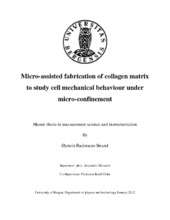Micro-assisted fabrication of collagen matrix to study cell mechanical behaviour under micro-confinement
Master thesis
Permanent lenke
https://hdl.handle.net/1956/15797Utgivelsesdato
2012-01-13Metadata
Vis full innførselSamlinger
Sammendrag
The aim of this work has been to optimize a microenvironment for study of the behaviour of living cells. This type of microenvironment has previously been used to compare adhesion ability for different cell types and those experiments have indicated a potential application in diagnostic of oral cancer [1]. Bovine serum albumin (BSA) has been used to generate a protein repellent surface which is extra repellent to extra cellular matrix (ECM)-proteins. When adsorbed on a substrate ECM proteins (such as collagen type I used in this project) have the ability to support cell adhesion. Samples with series of parallel BSA stripes with micrometric width and millimetric length have been fabricated using the technique of micro-contact printing. An elastic material (PDMS) containing parallel ridges with the dimensions described were inked with a solution containing BSA and used to deposit stripes of BSA at a cover slip. The micro gaps between the stripes have been used to depose collagen I. We then have a substrate presenting strong variations for the adhesive interactions between cells and substrate. The patterned surface is large enough to study simultaneously a population of single cells. A vital part of this project has been to evaluate effects of variations in deposition of both BSA and collagen I. Collagen I have the ability to polymerize into fibers under suitable conditions. The polymerization of collagen depends on pH, and this parameter has been varied for different samples. Polymerization has been induced within micro-channels taking advantage of the material properties of PDMS to control the pH changes. We document interesting fabrication and control of the collagen polymerization, even if it was not possible to achieve a complete study of this complex micro-system. Atomic force microscope (AFM) has been used for imaging and quantification of characteristics of different samples. The AFMs ability to detect variations at the nanoscale has revealed the high degree of accuracy needed for this purpose. Finally some of the prepared samples were tested in cell experiments. BSA deposition of was tried using both hydrophobic and hydrophilic PDMS. Those experiments revealed a significant thicker BSA layer on the substrate using hydrophobic than hydrophilic PDMS. The concentration of glutaraldehyde used was also varied. Samples made using concentrations of 0,625%, 1,25% and 2,5% glutaraldehyde (diluted in PBS) did not give any significant differences. Having two layers of BSA on top of each other were found to give a denser layer. Experimentation with different methods of deposing collagen resulted in samples covered with collagen fibers of varying sizes and quantities and potensial for development is demonstrated. The cell experiments indicated only slightly different cell spreading dynamic on the samples chosen for those experiments and for the cell type used.
